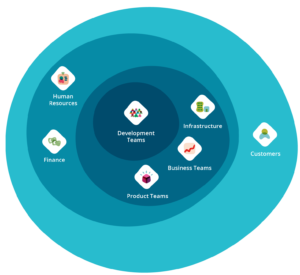Those of us who are experienced project and program managers will understand the relevance of stakeholder mapping. In fact stakeholder mapping is one of the key knowledge areas espoused by the Project Management Institute’s PM Book of Knowledge. Not surprisingly, stakeholder mapping is critical during an ownership transition as well. However, we are guilty of looking upon such projects through narrow prisms. In the process we overlook the roles of non-core teams and the enabling groups in a transition.
People Function
In the Agile world, teams comprise of individuals coalesced with social bonds. As one team hands over the reins of their platform to another, changes happen to individuals, teams, processes and to every part of the organisation to some extent. After all, when there are changes to people’s responsibilities, it will have an effect on their aspirations and motivations as well. Hence People Function teams have a big role to play in Ownership Transfer activities. Their involvement in ennobling the teams, both the incumbent as well as the new teams cannot be over stated. Incumbents would have questions regarding their next role, and whether such a project is a reflection on their performance. The HR teams can play a vital role in facilitating meaningful discussions and bringing down uncertainties.
Finance Teams
Almost always a transition is done with a larger transformation purpose. And what is any transformation if one cannot measure it in dollars? Costing of projects, during the transition will always be different as compared to how it was done prior to the transition. Similarly, one expects an efficiency increase to the flow of work, or perhaps expect to allocate a higher value to work post the transition. Given this, it is often surprising that we do not include the finance and costs department during an ownership transfer. Granted they may not be in the centre of action, but their involvement is crucial for us to decide and define how to measure the outcome of the transformation.
Infrastructure Teams
Ownership Transfers accompany changes to the infrastructure. These may range from completely overhauling non production environments to providing VPN access to remote locations. I am not adding production set-ups here, because changes to production environments are a huge program in themselves and almost always receive the appropriate management focus they need. But when it comes to non production environments and network additions, the level of focus on such activities are notoriously low as one gets started. Even in situations where there is awareness on infrastructure changes, these teams work in isolation to the development and release teams. One always ends up with access issues, performance issues and eventual loss of productivity. The infrastructure teams need to work closely with the development teams and hence are in lower orbits on such exercises.
Product Management
Today’s world is suffused with concepts of Agile and Lean. A critical element in a lean culture is for the technology and business teams to be working closely with each together. A product team would ideally comprise of individuals with cross-functional skills, all the way from development, testing, devops to product management. Naturally in the case of a transition; even one where only the technology members are changing responsibilities, the inputs and influence from the product and business members are crucial. The Ownership Transfer will not be complete without transferring the relationships established between the technology teams with the business groups.
The Customer
Lastly, but perhaps most importantly the customer. Customers are the reason why organisations survive and thrive. The purpose of a transfer can always be mapped to the value it will bring to the organisation’s customer. If efficiency is a reason, it should translate to quicker and better service to the customer. If cost is a reason, it could translate to a competitive price to the customer. And if technology re-haul is a reason for the transfer, it again maps back to serving the customer efficiently in a fast changing environment. A satisfied customer is like the north star during a transition. In the tumult of the transfer it will help for the leadership to step back and check at various points, if we are moving towards a giving satisfaction to our customer.
